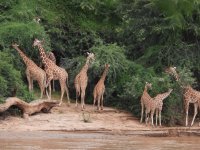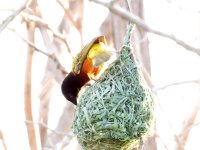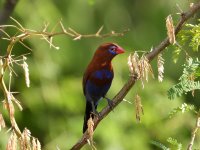At 7, we arrived at the entrance of the Ikuywa River trail with Winston, our local guide for Kakamega, this is an old trail that leads to a small village and throughout our time in the area we were reminded that the communities around here expect the women to be the ones to maintain the home, even if it means going to the forest to collect firewood that was sometimes bigger than them! On the bird front, activity started fast and many species were only seen as flashes of color crossing the road like African Pygmy Kingfisher and Red-headed Bluebill. High up in the canopy we encountered most of the species on the roadside, beginning with easier species like Joyful Greenbul, Sharpe's Drongo, Gray-headed Nigrita and Purple-throated Cuckooshrike. After going down the trail, we were eventually greeted by an understory species in the form of Brown-chested Alethe, this soon turned into a favorite as it was out in the open and we didn't have to risk "warbler neck" for it; other understory species included Black-faced Rufous-Warbler and Black-billed Weaver (seen only by 2 birders). Eventually, we connected with a calling African Emerald Cuckoo, the bird remained on an open snag for everyone to see, but the activity in the trees around it was the big catch as a mixed flock brought in many species we hoping to connect with. Some of the birds seen in this flock included Turner's Eremomela, White-chinned and Banded Prinia, Gray-green Bushshrike, Southern Hyliota, Pink-footed Puffback, Buff-throated Apalis and White-breasted Nigrita. Further down the trail we encountered another flock, this one being mostly represented by weavers and sunbirds, with Forest and Black-necked Weaver feeding alongside Green, Green-headed, Green-throated and Olive-bellied Sunbird. On the mammal front, Red-legged Sun Squirrel, Mantled (Mau Forest) Guereza (Eastern black-and-white Colobus) and Stuhlmann's (Blue) Monkey were the only sightings.
Back in the van, we drove down to the Pumphouse Trail in hopes to find a few more species for the morning, in a small clearing we had Least Honeyguide, Brown-eared Woodpecker and Petit's Cuckooshrike. As we walk through the trails, we are greeted by White-headed and Black Sawwing overhead, and given a crash course in African forest birding by the spike of greenbul variety, Slender-billed, Joyful, Ansorge's, Yellow-whiskered and Little Greenbul all make an appearance. Alex said you can tell the quality of a forest by how many species of greenbuls you encounter within an hour, if the number is 5 or higher, you are in good forest habitat, and thankfully that seemed to be the case, even in the midday heat. However, we soon were told that we weren't just doing a generic walk to pick up any species like in the river trail, instead we were targeting a member of one of the most sought-after bird groups in Kakamega, the Yellow-bellied Wattle-eye. Kakamega Forest is home to 4 species of Wattle-eye, small colorful passerines found only in the forests of Africa, we had seen Brown-throated Wattle-eye on the walk, but Yellow-bellied is trickier as it is usually found when they set up a new territory and for that, Winston's expertise was greatly appreciated as a lot of bushwhacking was needed before we reached the area where the bird called. Eventually, everyone got good views of it and some even managed to get some record shots, but to call these birds hyperactive would be an understatement and a foreboding challenge for what we had tomorrow. On the walk back to the truck we encountered our last oriole for the trip, Western Black-headed Oriole, and it signaled a great ending for the morning birding.
After lunch and a nap, only half of the group had the will to do afternoon birding around the lodge due to the rain, but the rewards for those that toughed it out were amazing, with a clear highlight being close-up views of Great Blue Turaco, these ended up being the most common birds we would encounter this afternoon. While waiting out the rain, we scoped out Stuhlmann's Starling and Yellow-spotted Barbet in the canopy, but when the rains eventually gave us a chance and walking through the Centre trails we connected with Gray-winged Robin-Chat, Black Cuckoo and a territorial pair of Yellow-billed Barbet. As light was becoming a desired necessity, we left the trail and went out to the main road, not much was seen except some flyover African Green Pigeon and a pair of Yellow-fronted Canary.
When doing the checklist that night, I realized that I accidentally saw and photographed an uncommon mammal of Kakamega, the Forest Giant Squirrel, needless to say, I felt bad for not pointing it out at the time, but didn't want to risk flushing the bird we were targeting. The last new mammal of the day however, came in courtesy of some spotlighting around the lodge grounds after dark. We found a confusing mammal that left everyone wondering what it could be due to bad lighting conditions and odd angle/behavior of the animal. The options ranged from a species of Greater Galago to a Potto; but the final verdict was that the mammal in question was likely a Two-spotted Palm Civet, a small feliform usually found in the trees around the Centre but didn't stop us from hoping for a rarer mammal!















































